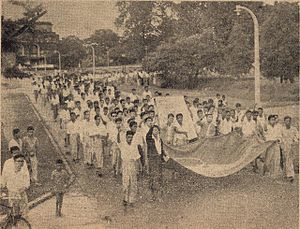Rangoon University Student Union massacre
| 1962 Rangoon University protests ဆဲဗင်းဂျူလိုင် ကျောင်းသားအရေးတော်ပုံ |
|
|---|---|
 |
|
| Date | 7 July 1962 – 1963 |
| Location | Rangoon, Burma (Myanmar) |
| Caused by | unjust university rules |
| Methods | Civil resistance, demonstrations, nonviolent resistance |
| Status | violently suppressed |
| Casualties | |
| Death(s) | 17- 130 |
| Injuries | Unknown |
| Arrested | Unknown |
The 1962 Rangoon University protests were a series of marches, demonstrations, and protests against stricter campus regulations, the end of the system of university self-administration, and the policy of the new military regime of General Ne Win. The main events took place in Rangoon, Burma (Myanmar) on 7–8 July 1962.
On July 7, 1962, the military regime violently suppressed a student demonstration at Rangoon University attended by some 2,000 students with military forces resulting in the death of more than a hundred and the arrest of more than 3,000 students according to unofficial but reliable sources. However, official government statements put the death toll at 15. In the morning hours of the next day, the military regime blew up the historic Rangoon University Student Union (RUSU) building, which had been the symbol of the anti-colonial nationalism struggle since the 1920s.
The reaction of the military regime disclosed for the first time its new tough stance against all regime opponents as part of implementing the new state ideology, the Burmese Way to Socialism, which included to bring "almost all of Burma's political, social, and economic life under strict military control". It also demonstrated that the effective suppression of student activism and the de-politicisation of the universities ranked high among the strategic goals of the new government as students had been in the vanguard of the Burmese anti-colonial nationalist struggle ever since the first student protests in Burma started in 1920. Although the regime had been successful in ending the student protests, the violent reaction nonetheless undermined its support among the broader population and created a symbolic focal point for later student protests in the following decades.
In the aftermath of the violent crackdown on the student protests, the Government of Ne Win immediately closed all universities for four months and sent all students home. Broad institutional reforms introduced by the 1964 University Education Act, then, brought Burma’s universities under strict government control and profoundly hampered cohesive open student activism in subsequent decades. In this respect, the result of the 1962 Rangoon University protests ushered a new era of underground student activism in which open mass student involvement in national politics erupted only sporadically, most prominently during the student protests of the mid-1970s and during the 8888 Uprising in 1988.
...
Wikipedia
